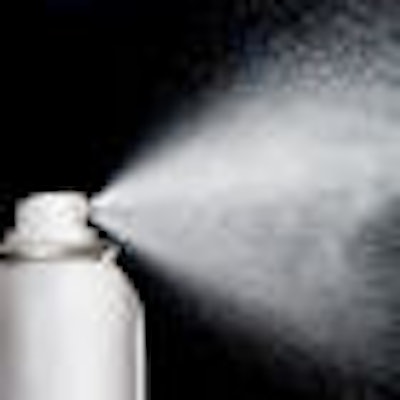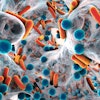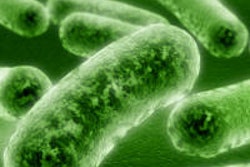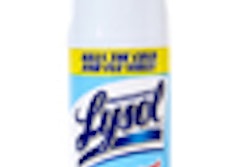
Spray zealots, beware: Your good intentions may be harming your health and the health of others in your office.
Overused disinfectant sprays launch masses of aerosols into the air, prompting headaches, dermatitis, coughing, and eye irritation, according to an infection-control expert.
“People who are ... overspraying may actually be hurting themselves and others.”
— John Molinari, Ph.D.
At the recent 2009 Pacific Dental Conference in Vancouver, British Columbia, John Molinari, Ph.D., discussed the downsides of overspraying and other common infection-control problems.
"I've seen many spray zealots," said Molinari, a professor of biomedical sciences and the director of infection control and safety, dentistry at the University of Detroit Mercy School of Dentistry. "When the AIDS pandemic hit in the early to mid '80s, people were overspraying with disinfectants. But we've gradually realized that HIV is not easily transmissible. So people who are still overspraying may actually be hurting themselves and others."
Even equipment can be damaged by overspraying, when the spray accumulates as liquid and is not removed, Molinari said. Thus, everyone should be taught to use disinfectant spray products appropriately, he emphasized.
Reading between the guidelines
The most recent guidelines for infection control in dentistry were produced in 2003 by the Centers for Disease Control and Prevention. They did not discuss spraying, so workers must be taught to "read between the guidelines" and not to overspray, Molinari said.
But the document does cover every other aspect of environmental infection control. For example, the guidelines deal at length with hand hygiene and personal protective equipment, including gloves. This is because contaminated hands are the single greatest sources of infection. According to hospital studies, 60% to 70% of nosocomial infections originate from hands (see 2003 guidelines), Molinari noted.
People in dentistry generally are doing a good job of following hand hygiene recommendations, but there are a few gaps between practice and recommendations, he said.
"Alcohol-based hand rubs and sprays are used as an adjunct to hand washing with soap and water, which is good. So what's the problem?" he asked. "The problem is some professionals aren't using them for a long enough period of time."
|
More tips for infection-free dentistry
|
The Organization for Safety and Asepsis Procedures (OSAP) points out that there is actually no 15-second requirement. Rather, the key is to cover all areas of the fingers and hands evenly with the rub, and to continue until the rub evaporates.
The real problem is recognizing that hands must be free of dirt and debris before using these products, said Doni Bird, R.D.H., R.D.A., OSAP's current chair-elect.
"Contributing to this misconception is the widespread use of these products in many public spaces, such as restrooms and supermarkets," Bird said. "Better education and product labeling would be of service to the public and professionals."
Another area in which dental health workers must read between the guidelines is the use of disinfectant wipes. Molinari cited a 2008 study that showed the common practice of using a single wipe for a large surface area does not accomplish disinfection but, in fact, can spread microbes across the surface (Williams G, et al, 2008 General Meeting of the American Society for Microbiology).
What the study "showed was that while the wipes may provide an effective alternative to sprays, they still need to be used according to manufacturers' directions," he said. "The manufacturers have increased the capacity of the wipes to hold liquid disinfectant. But dental personnel still need to use separate wipes for initial cleaning and subsequent surface disinfection."
Molinari recommends that each wipe be used only for an area that's small enough so that the liquid disinfectant does not evaporate within the manufacturer-recommended interval.
What about water cleaning?
Another place where confusion exists is in the choice of systems to keep dental-unit water lines free of bacteria. So many products are vying for FDA and Environmental Protection Agency approvals that keeping track of each system's strengths and weaknesses can be hard, Molinari noted. In addition, many people harbor the misconception that biofilms cannot develop in dental units that use a self-contained water system and/or sterile or distilled water.
He recommends asking the manufacturer or sales representative for a letter of approval of the system from the appropriate government agency. This helps the healthcare professional check that the system has the approval and capabilities that the company says it has.
Molinari noted that basic infection-control principles apply to dental water line asepsis.
"A fundamental principle of infection control is 'Clean it first,' " Dr. Molinari said. "You need to clean your hands before you put on gloves. You clean instruments before you sterilize them. You clean surfaces before you disinfect. So why not clean water lines before you prevent biofilm accumulation?"
Eve Cuny, M.S., a member of OSAP, said that dental practitioners should also look for other characteristics in a water line cleaning system.
"It should deliver treated water that has no more than 500 colony-forming units of heterotrophic water bacteria per milliliter, which is the U.S. Environmental Protection Agency's standard for drinking water," she noted. "You should also read the biocompatibility information that comes with the system to ensure that it can be used with your brand of dental equipment. And, of course, you should also make sure that when it is used it is safe for patients and staff and that, for example, the treated water does not contain hazardous chemicals."
Copyright © 2009 DrBicuspid.com



















